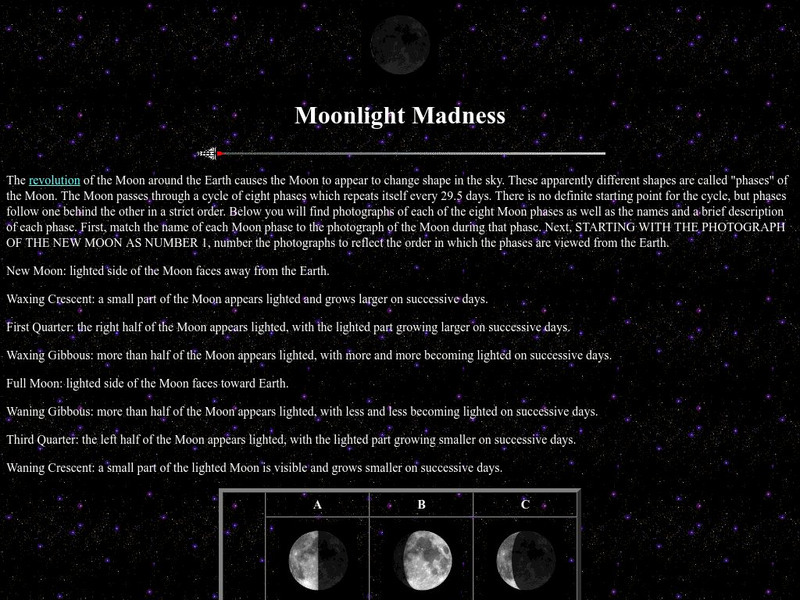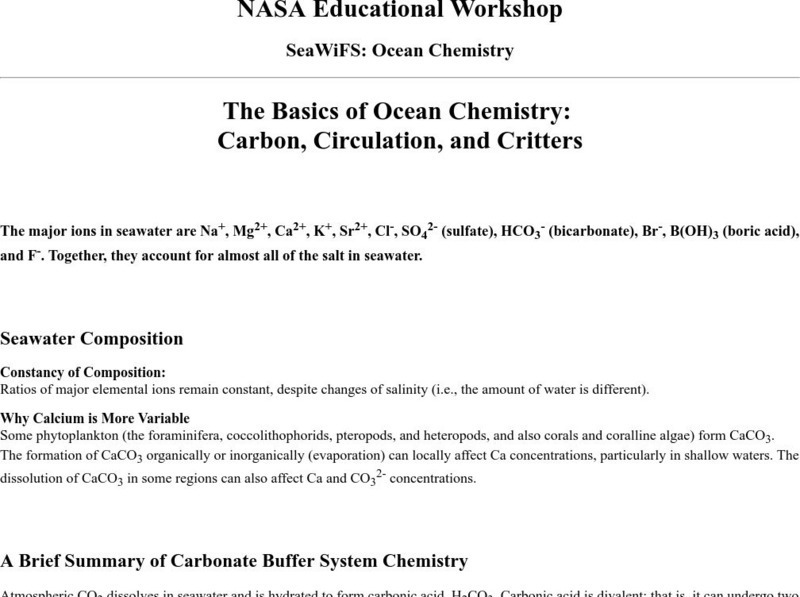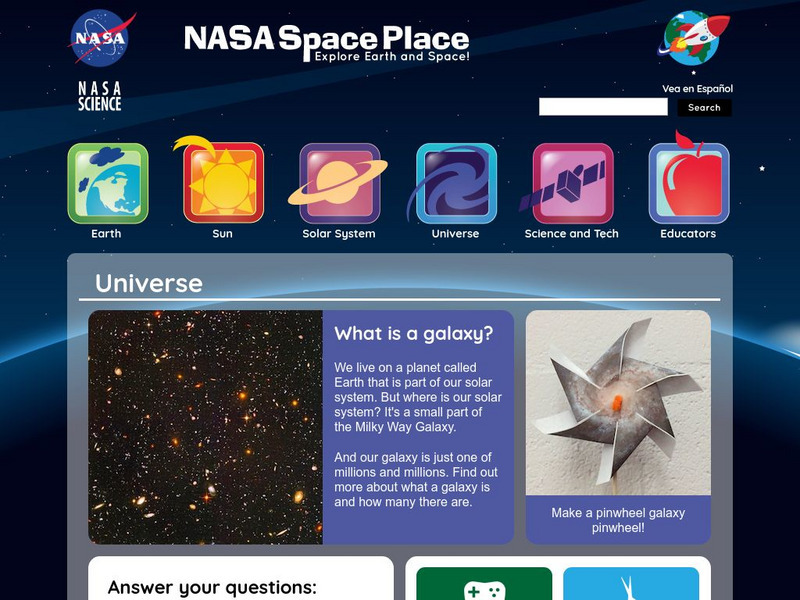NASA
Nasa Star Child: The Solar System
Discover information about parts of the Solar System, along with definitions just by clicking on highlighted vocabulary terms. Be sure to try the "Solar System Activities" to review the material from these pages.
NASA
Nasa: The Space Place: The Land of the Magic Windows
This is a site from NASA that contains an interesting and fun way to learn about the electromagnetic spectrum. Kate receives a strange riddle from her grandfather. Find out what it says and go through the gateway to the Land of the Magic...
NASA
Nasa: Sea Wi Fs Project: Studying Ocean Color From Space
Five different oceanography topics are addressed by this resource. The first two topics deal with satellite imagery of the oceans and the last three address ecological issues.
NASA
Nasa: Imagine the Universe: Speed of Earth's Rotation
Presents an informative answer to the question "What is the speed of the turning of the Earth?"
NASA
Nasa: Space Place: Make a Topographic Map
Find out what topographic maps are and how to make them. The instructions are complete with pictures to help you construct a mountain of clay and and a corresponding topographic map.
NASA
Nasa: The Space Place: What Is Gravity Really?
What is known about gravity? Find out Einstein's thoughts on gravity in a brief overview of this mysterious force.
NASA
Nasa Earth Observatory: Mystery of the Missing Carbon
This article discusses the mystery of the one to two billion metric tons of missing carbon from the global carbon budget. Scientists do not know where between fifteen and thirty percent of the carbon released each year disappears to, but...
NASA
Nasa Earth Observatory: Modeling Earth's Land Biosphere
Read this article to learn how scientists are using instruments to try and monitor our land biosphere. Scientists have learned two different types of models to help track data from our land.
NASA
Nasa: Imagine the Universe: Black Holes
Resource introduces black holes at two different levels. Take a journey through a black hole, discover what a wormhole is, and discover how we know black holes are there. Includes a quiz on the information presented.
NASA
Nasa: Imagine the Universe: White Dwarfs
Brief description of white dwarfs with respect to their position in the life cycle of stars, the density of white dwarfs, the emissions of white dwarfs, and the temperatures associated with them.
NASA
Nasa: Weight and Balance Forces Acting on an Airplane
The effects of forces exerted on an airplane wing are discussed both conceptually and mathematically. Illustrations and sample problems and solutions are provided.
NASA
Nasa: Heasarc: What Are Pulsars?
A detailed definition of a pulsar with an explanation of the relationship of pulsars to X-ray astronomy and links to related resources.
NASA
Nasa: Wmap: Fate of the Universe
A general look at the expansion of the universe and the Big Bang theory.
NASA
Nasa Star Child: Star Child
StarChild from NASA defines and describes the Solar System in a simple and easy-to-understand manner. The website is broken down into two versions for the student, grade school and junior high.
NASA
Nasa: Electromagnetic Spectrum: Radio Waves
Radio waves have the longest wavelengths in the electromagnetic spectrum. This NASA article discusses AM, FM, TV, cell phone, as well as radio astronomy, which all use this technology.
NASA
Nasa: Magnetic Fields
This site from NASA provides a short, illustrated description of the basics of magnetic fields and magnetic poles.
NASA
Nasa Star Child: Moonlight Madness
The revolution of the Moon around the Earth causes the Moon to appear to change shape in the sky. These apparently different shapes are called "phases" of the Moon. The Moon passes through a cycle of eight phases which repeats itself...
NASA
Nasa: The Sun's Energy Source
This site, which is provided by NASA, gives some scientific history and a clear and detailed explanation of nulcear forces and nuclear fusion.
NASA
Nasa: Eclipses
The periodicity and recurrance of eclipses is governed by the Saros cycle, a period of approximately 6,585.3 days (18 years 11 days 8 hours). It was known to the Chaldeans as a period when lunar eclipses seem to repeat themselves, but...
NASA
Nasa: The Basics of Ocean Chemistry: Carbon, Circulation, and Critters
An explanation of ocean chemistry, supported by illustrations, for example, of the global carbon cycle in the 1980s and the annual carbon dioxide flux. The concentration of nutrients in the ocean is discussed for its impact on marine...
NASA
Nasa Science: For Kids: The Universe
Test your knowledge about the universe with games and activities designed to help explore what you know.
NASA
Nasa Science: For Kids: Solar System Fun
Test your knowledge about the solar system with games and activities designed to help explore what you know about the sun, the planets and their moons, space rocks, the Milky Way, and related topics.
NASA
Nasa: Space Place: Space Volcanoes!
Click and explore the solar system to discover where volcanoes can be found, on planets and moons.
NASA
Nasa: Cosmicopia: Nucleosynthesis
NASA's Cosmicopia illustrates the process of element creation in the universe.






















